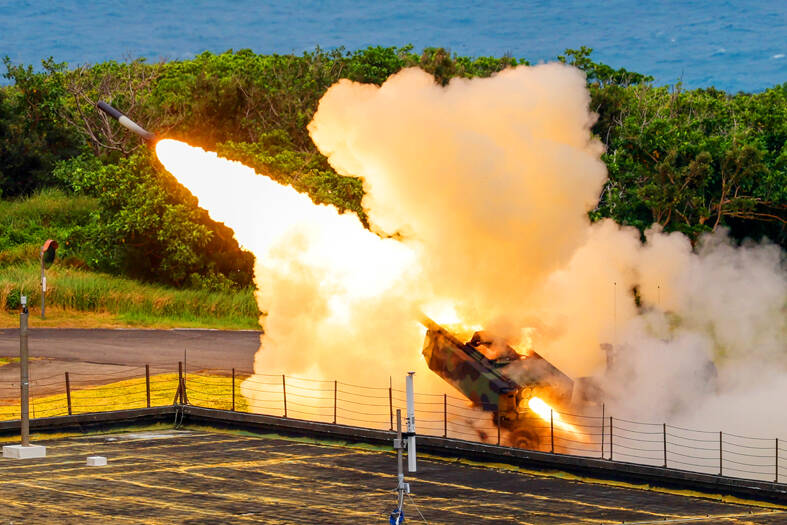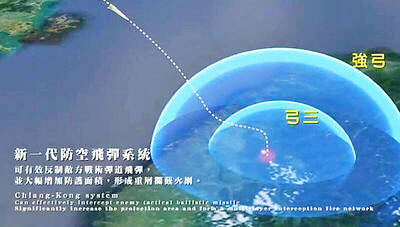Taiwan plans to procure 28 more sets of M-142 High Mobility Artillery Rocket Systems (HIMARS), as well as nine additional sets of National Advanced Surface-to-Air Missile Systems (NASAMS), military sources said yesterday.
Taiwan had previously purchased 29 HIMARS launchers from the US and received the first 11 last year.
Once the planned purchases are completed and delivered, Taiwan would have 57 sets of HIMARS.

Photo: Ritchie B. Tongo, EPA-EFE
The army has also increased the number of MGM-140 Army Tactical Missile Systems (ATACMS) purchased from 64 to 84, the sources added.
Each HIMARS launch pod can carry six Guided Multiple Launch Rocket Systems, capable of striking targets 70 to 85km away, or one ATACMS, which has a range of 300km and circular error probability of 5 to 10m.
On May 12, the 58th Artillery Command conducted the first live-fire HIMARS drill at Jiupeng Base in Pingtung County’s Manzhou Township (滿州). The system was also tested by the Army Command Headquarters in June.

Photo courtesy of the Norwegian Ministry of Defense
The military is also planning to purchase nine additional sets of NASAMS, an L-band electronic array radar and a non-L-band electronic array radar to bolster the air defense of central and southern Taiwan, as well as 339 missiles of various types, the sources said.
Taiwan and the US previously signed a NT$24.99 billion (US$837 million) procurement contract for three NASAMS.
The first set of the three is expected to be delivered by the end of this year, sources said, adding that the NASAMS would be deployed near the capital to bolster its air defense.
The NASAMS can fire missiles used by fighter jets if the runways have been bombed, enabling air defense even if fighters are unable to take off, the source said.
If NASAMS are equipped with the extended range version of the AIM-120 Advanced Medium-Range Air-to-Air Missile, they would have a range of 50km, complementing the air force’s longer-range Patriot and Tien Kung missiles, as well as the shorter-range surface-launched Tien Chien II and AN/TWQ-1 Avenger Air Defense System, they added.
The planned procurement of the additional 28 sets of HIMARS would cost about NT$40 billion, while the planned purchase of nine more NASAMS and missiles of various types is expected to cost NT$110 billion, they said.
Upon approval by the Executive Yuan, the military would first deliver the special act for military procurements to the legislature for review, sources said.
The draft special budget act for military procurements would be delivered to the legislature after the special act for military procurements is passed, and only then would the special budget amount be made known, they added.

LIMITS: While China increases military pressure on Taiwan and expands its use of cognitive warfare, it is unwilling to target tech supply chains, the report said US and Taiwan military officials have warned that the Chinese People’s Liberation Army (PLA) could implement a blockade within “a matter of hours” and need only “minimal conversion time” prior to an attack on Taiwan, a report released on Tuesday by the US Senate’s China Economic and Security Review Commission said. “While there is no indication that China is planning an imminent attack, the United States and its allies and partners can no longer assume that a Taiwan contingency is a distant possibility for which they would have ample time to prepare,” it said. The commission made the comments in its annual

DETERMINATION: Beijing’s actions toward Tokyo have drawn international attention, but would likely bolster regional coordination and defense networks, the report said Japanese Prime Minister Sanae Takaichi’s administration is likely to prioritize security reforms and deterrence in the face of recent “hybrid” threats from China, the National Security Bureau (NSB) said. The bureau made the assessment in a written report to the Legislative Yuan ahead of an oral report and questions-and-answers session at the legislature’s Foreign Affairs and National Defense Committee tomorrow. The key points of Japan’s security reforms would be to reinforce security cooperation with the US, including enhancing defense deployment in the first island chain, pushing forward the integrated command and operations of the Japan Self-Defense Forces and US Forces Japan, as

INTERCEPTION: The 30km test ceiling shows that the CSIST is capable of producing missiles that could stop inbound missiles as they re-enter the atmosphere Recent missile tests by the Chungshan Institute of Science and Technology (CSIST) show that Taiwan’s missiles are capable of intercepting ballistic missiles as they re-enter the atmosphere and pose a significant deterrent to Chinese missile threats, former Hsiung Feng III missile development project chief engineer Chang Cheng (張誠) said yesterday. The military-affiliated institute has been conducting missile tests, believed to be related to Project Chiang Kung (強弓) at Pingtung County’s Jiupeng Military Base, with many tests deviating from past practices of setting restriction zones at “unlimited” and instead clearly stating a 30.48km range, Chang said. “Unlimited” restrictions zones for missile tests is

PUBLIC SAFETY: The nationwide distribution campaign aims to enhance society’s overall understanding of threats and bolster defense awareness, an official said The latest edition of the National Public Safety Guide is being mailed to all citizens starting today to foster public awareness of self-defense in the event of war or natural disasters, the Ministry of National Defense said yesterday. “The guides will be disseminated to the public to enhance society’s overall understanding of threats and bolster defense awareness, demonstrating the government’s emphasis on people’s safety and its determination to pursue self-defense,” All-out Defense Mobilization Agency Director Shen Wei-chih (沈威志) said at the ministry’s news conference. The nationwide distribution campaign was planned according to President Lai William’s (賴清德) Sept. 20 directive, he said, adding